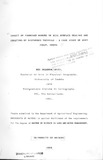| dc.description.abstract | The effects of two farmyard manure application rates (5 and 10 t
ha-1) on infiltration, runoff, soil loss and soil crust strength
of four disturbed topsoil samples from luvisols (FAD/UNESCO, 1974
classification) were investigated under laboratory conditions for
60 days. The experiment was conducted in three experimental phases
of 20 days each.
The four topsoil samples were packed in soil trays and subjected
to simulated rainfall of a constant intensity of 360 mm h-1 for
three minutes on four consecutive days.
Each of the three treatments of 0, 5 and 10 t ha-1 manure
application rates was replicated three times and was subjected to
similar experimental procedures as other replicates.
The investigations on the topsoil samples were confined to the top
5 cm layers from which time to runoff, infiltration capacity,
runoff and soi 1 loss were measured on each day of rainfall
simulation. Crust strength and moisture contents were monitored
over a period of two weeks after the last simulation day of each
experimental phase. Crust organic matter content and the degree
of soil aggregation were determined after each experimental phase.
Results show that soil aggregation changed slightly with time and
with manure application. There were increases of between 2 and
14.4 Y. in the percentage of aggregates of sizes less than 250 ~m
and those greater than 2 mm. Aggregates of sizes ranging between
250 ~m and 2 mm were generally reduced with a maximum decrease
reaching 10.5 Y..
Crust organic matter content decreased by the end of the 60 day
period of study between 0.36 % and 1.17 % for all the four topsoil
samples. The 5 t ha-1 treatment gained in organic matter content
between 0.12 Yo to 0.46 Yo while the 10 t ha-1 treatment gained
between 0.50 Y.to 0.86 %.
At 0.05 probabi 1ity level, time to runoff and the amount of
surface runoff were signi ficantly influenced by the day of
simulat ion, topsoi 1 type and soi I surface condi tions. Time to
runoff decreased with time while differences in the amount of
runoff between treatments were insignificant.
There were significant increases in soil loss (at 95 Yo confidence
level) with the addition of manure to the topsoil samples from
chromic and plinthic luvisols especially during the first
experimental phase.
Influences of topsoil type on soil 1055 were noted with the clay
loam topsoil sample from orthic luvisol (sample D) having
significantly more soil loss than other topsoil samples. least
soil losses were from the sandy clay loam topsoil sample from
orthic luvisol (sample B) and the sandy loam topsoil sample from
chromic luvisols (sample A).
The moisture content of crusts varied with topsoil type. Clay loam
topsoi I from orthic luvisol showed some significant crust moisture
increase with manure application rate.
Crust strength increased significantly when the crust moisture
content was below 4 Yo. Thus, there was a decrease in crust
strength with any increase in moisture content as was expected.
The investigations showed that adding 10 t ha-I farmyard manure to
the four topsoil samples of the luvisols studied increased soil
loss. This could be attributed to improved soil aggregation and
lowered soil bulk density due to the significant increase in soil
organic matter content. Generally, there was an increase in crust
moisture content, improved soil aggregation and decreased crust
strength with the increase in farmyard manure appIication. Surface
runoff and infiltration capacities were not significantly affected
by the treatments at 95% confidence level. | en |

